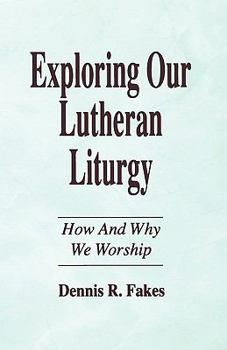< Back to Search Results
Exploring Our Lutheran Liturgy
Select Format
Select Condition 
Book Overview
I love this church and its liturgy and know that something very valuable is weekly unappreciated by millions of us. That ""something"" in the author's preface is the Lutheran liturgy. Understanding that liturgy is ""the work of the people in worshiping God."" Dennis R. Fakes presents this volume that will assist lay people and clergy to understand and appreciate the powerful messages of the liturgy. Uses for this book include: Worship or new member classes Worship and music committee workshops A sermon series A liturgy handbook for worship leaders The guided reflections for each part of the service provide a gospel-centered focus to the purpose of liturgy as it enhances richness and meaning to one's understanding of God's presence and invitation in the worship service. Paul R. Swanson, Bishop Oregon Synod, ELCA Not only a book for serious students of liturgical life, but also for the new Christian. The author has taken the hard work out of reading liturgical books written for all Lutherans, it is sensitive to all traditions. Eugene E. Schmidt, District President Kansas District-LC-MS I can visualize this book being utilized to not only introduce persons to the Lutheran Church and the Lutheran Liturgy but also to enable a far greater appreciation of the liturgy by those who may have been Lutherans for decades. Robert H. Studtmann, Bishop The Arkansas-Oklahoma Synod, ELCA Dennis R. Fakes, pastor at Messiah Evangelical Lutheran Church, Lindsborg, Kansas, received undergraduate degrees from St. John's College, Winfield, Kansas, and Concordia Senior College, Fort Wayne, Indiana. He holds a master's of theology degree from Lutheran School of Theology, Chicago. This is his third CSS book.
Format:Paperback
Language:English
ISBN:1556735960
ISBN13:9781556735967
Release Date:January 1994
Publisher:CSS Publishing Company
Length:148 Pages
Weight:0.05 lbs.
Dimensions:0.3" x 5.5" x 8.5"
Customer Reviews
1 rating
Simply and plainly explains it
Published by Thriftbooks.com User , 21 years ago
This is a good, simple book that will help any reader become more familiar with the Lutheran liturgy. It is written in general terms, and differences between the ELCA and LC-MS are noted when appropriate. The book is useful to any synod. As the title suggests, it explains the Lutheran Liturgy. The first chapter describes the physical layout of the church building, why the minisiter wears the colors s/he does when, and the church year. The second chapter covers the invocation and the confession; the third chapter the entrance hymn, greeting, kyrie, and hymn of praise, and so on through the chapters, with the eighth containing the Lamb Of God, Dismissal, Post-Communion Canticle, Prayer, and The Blessing. There is a good bibliography in the back. The table of contents resembles what is listed in the Bulletin during Sunday worship services. The tone of the book is very casual, and the author explains some things like what the X in XMAS stands for and what IHS means. He briefly discusses the different ways of receiving communion; for example, why we sometimes stand for communion, why we sometimes sit for communion, and who may receive communion in the Lutheran Church. It is an easy read and I strongly recommend the book for anyone attending Lutheran Church services; it answer the questions of "why is the pastor doing that?" and "why is the pastor wearing purple today?"






